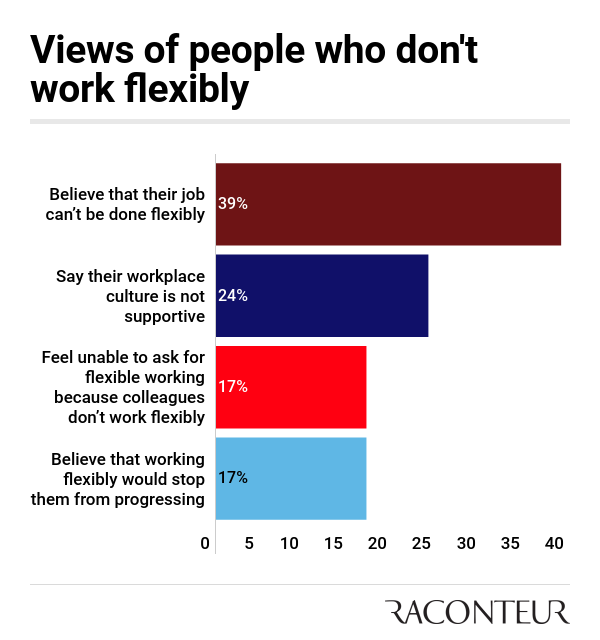For some professions, implementing flexible working is much harder than in others. A Smarter Working Initiative study, for example, found that charity, manufacturing and professional services are the worst sectors for flexible working.
Offering flexibility as part of the compensation package can provide access to talent companies could not otherwise afford
While it may seem impractical to offer agile working in certain roles, particularly those that are client facing or require specialist technology, in actuality, it is nearly always achievable, says Clair Hodgson, Europe, Middle East and Africa director at How Do You Do It?
Flexible working needs to start with discussion and strategy
Ms Hodgson works with professional services companies, such as Deloitte, Zurich and KPMG, to attract, retain and progress talented staff, particularly working parents.
To start integrating flexible working into any organisation, the intention must be established at the executive level, she says.
“Decision-makers should have a clear discussion and communicate its output across the business; line managers need to know what they have permission to do and not to do,” Ms Hodgson explains.
Deloitte, for example, launched an initiative for parents returning to the workforce that provided active support for agile working and clear statements around the acceptability of working from home when possible.
Companies should consider the types of flexible working that exist, including jobs shares, homeworking, part-time roles and annualised hours, and decide what is the best fit for their business. Once these key decisions are made, engagement should start at the individual level so everyone knows what their role is, Ms Hodgson says.
Manager mindset needs to establish flexibility as default
Though it can be challenging, especially when working directly with clients to tight deadlines, it’s worth remembering that all firms face the same issues.
Even in unusually hard-to-adapt situations, there can be a solution, says Duncan Brown, head of human resources consultancy at the Institute for Employment Studies. But beware of untrained line managers being a barrier to adoption, he adds.
“Flexibility should be the default position; in other words, the manager has to argue why the employee cannot have it. It’s about not having a fixed mindset,” Mr Brown says.
He suggests an organisation should segment the workforce into those who want predictable pay and hours, and those who want to prioritise adaptability.
Recruiters must also be willing to promote flexible working
This can be advantageous to both the employer and the employee. For example, Manon DeFelice, chief executive and founder of Inkwell, a recruitment network aimed at finding flexible executive placements for parents, says offering flexibility as part of the compensation package can provide access to talent companies could not otherwise afford.
For example, Inkwell placed a chief financial officer at technology startup Paddle8 on a four-day week. When the company matured and was sold, she went to tech unicorn Giphy, which matched her flexible package, and where she worked while the company was raising millions in investment.
“When you are compensating someone in this way, you are paying them for their performance, not just to be present all the time,” says Ms DeFelice.
Conversely, however, at times recruiters can be a barrier to making roles flexible, says Katy Fridman, a former marketing director at Microsoft and founder of the Facebook Group Flexible Working for Mums Like Me (Dads Welcome).
Ms Fridman says recruiters need to start pushing their clients on flexible working and not rely on automation alone to find candidates.
“Recruiters are acting as gatekeepers to the flexible movement,” she explains. “They say my clients aren’t interested, but I know from experience that actually, when the issue is pushed, there are many models both can consider.”
Training and an open mind can find flexibility where there was none
Octopus Energy, for example, has taken an entirely different approach to customer service management, abandoning the traditional call-centre model. Chief executive Greg Jackson says one of his millennial employees built a platform that enables 28 staff to work remotely, answering out-of-hours customer queries via social media and email, as well as amending back-end technical issues.
Using scheduling software, the DigiOps team arrange rotas on a weekly basis depending on people’s availability and needs. Employee productivity is automated and measured by customer satisfaction. “By doing this, we suddenly tapped into a very deep talent pool,” says Mr Jackson.
Equally, changes can be small and subtle. In the manufacturing sector, which typically works to tight deadlines, Ruth Hancock, operating director for recruitment agency Michael Page, says upskilling employees, so they can pick up each other’s roles if they are not on site, can “lessen the rigid ‘this is my job and no one else does it’ mentality and help end the clock-in-clock-out culture”.
Finding ways to incorporate some adaptability into the workplace is the future of working, with the predominant millennial workforce demanding it the most. Therefore, those companies that embrace it the quickest will have access to the best talent.
Flexible working needs to start with discussion and strategy
Manager mindset needs to establish flexibility as default
Recruiters must also be willing to promote flexible working

